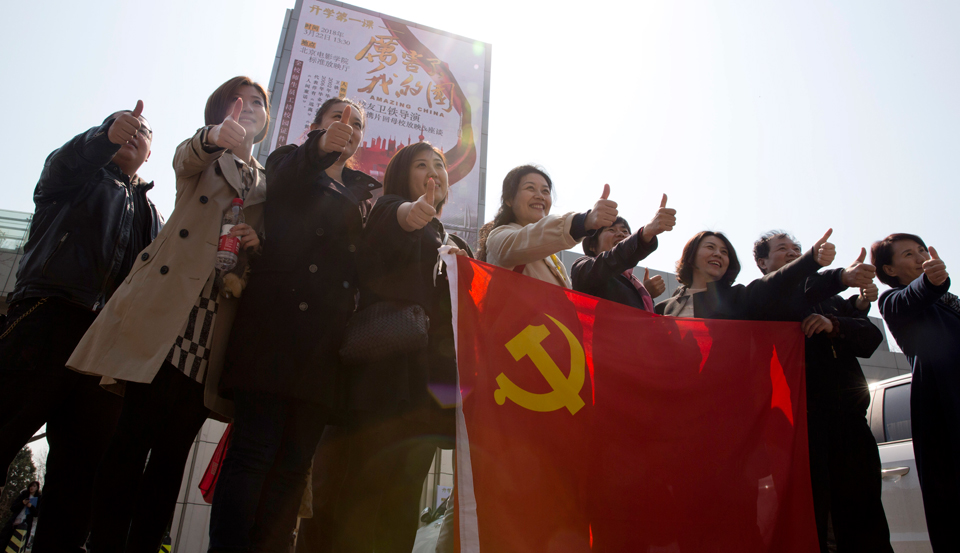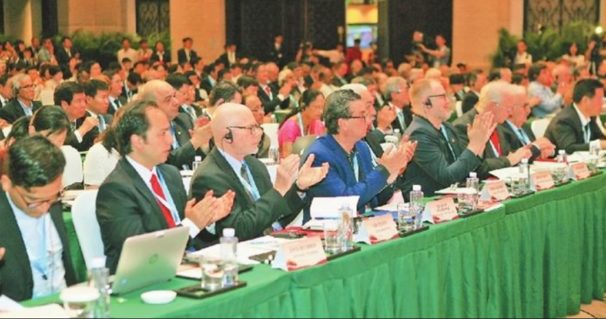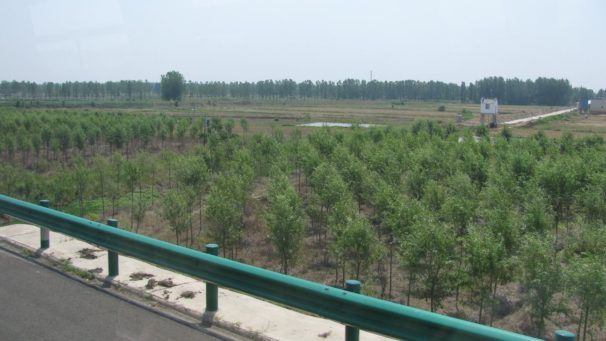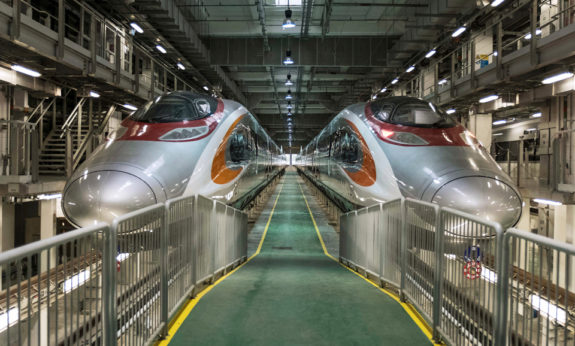
At the invitation of the Communist Party of China, a delegation from the Communist Party USA toured China May 26-June 3 and attended a conference on the 200th anniversary of Karl Marx’s birth. John Bachtell, the party’s chairman, and Carol Widom represented the CPUSA at the conference. Bachtell’s remarks to the meeting were published by People’s World previously. Below are some of his impressions, originally published at CPUSA.org, of China’s development and its progress in building socialism after returning from the trip. Further articles on selected topics will appear in People’s World in the future.
China is undergoing rapid and profound changes that will have an enormous effect on the nation’s 1.4 billion people, the global economy, international relations, and the future of socialism.
While there, we got a glimpse of some of these changes. We were invited to attend a forum to celebrate the 200th birthday of Karl Marx with 70 communist, socialist, left, and revolutionary parties in Shenzhen, an eco-planned city, followed by a week touring Beijing, Hefei, Fengyang County, and Xiaogang Village, the site of the first rural economic reforms.
The event reflected the feeling by the Communist Party of China (CPC) that a qualitative turning point has been reached in socialist construction and that China is playing a new role on the global stage. The meeting is an example of China and the CPC opening wider to the world and expanding and deepening relations with communist and workers’ parties.
The schedule was geared to familiarize us with developments in China and CPC policies for “building socialism with Chinese characteristics” in a new era; reforms in the economy, governance, and the party; the country’s approach to international relations; and the role of the CPC itself.
New era
The world is entering a “new era” of global relations driven by China’s peaceful ascendance and the decline of U.S. and Western imperialism. It will affect everything from global economic relations to global politics and the dynamics among communist and workers’ parties.
The economic and social developments in China in the 40 years since the start of socialist market reforms and opening to the global economy under the leadership of Deng Xiaoping are staggering and unprecedented in human history. China has leapt from an underdeveloped economy to a largely modern one almost overnight. Within a decade, China will be world’s largest economy as measured by GDP.
A recent Ipsos survey revealed 90 percent of Chinese were satisfied with their country’s path, while only 37 percent of Americans and 11 percent of French said the same.
But the pace of development came at a cost and also brings its own set of problems and challenges. These include subsuming worker rights to overall development, the growth of the capitalist sector with all its risks, contradictions, and economic inequalities. Also there is the emergence of a billionaire class, along with sharpening class struggle, imbalances between urban and rural economies, and a growing contradiction between increasing needs and the ability to address them. There is all of that, as well as an intensifying ideological struggle and the impact of development on the environment.

Social equality and consciousness tend to trail behind, far behind in some instances.
According to the CPC, China is in the primary stage of socialist construction; it remains a developing country. One could deduce this refers not just to the country’s economic and material level of development, but also to its democratic institutions, civil society, and political culture.
Nevertheless, China has achieved a standard of living where everyone can live a “moderately prosperous life.” By 2050, the goal is to achieve fully modern, democratic, sustainable socialism. The CPC sees the main contradiction as being that between imbalanced growth and the growing expectations and needs of the people.
Economic growth is nearly 7 percent a year, and China already accounts for 30 percent of global economic growth. China poured more concrete in the period 2011-13 than the U.S. did in the entire 20th century.
700,000,000 people have been brought out of extreme poverty since the reforms began. This accounts for 70 percent of poverty reduction worldwide in the period. The party says China will eliminate poverty entirely in the next 3-5 years. Most remaining extreme poverty is in rural and remote areas, and many of these communities will be relocated.
The standard of living is also being raised. Wages, while still low by U.S. standards, have risen for factory workers by 64 percent since 2011 and are now on par with workers in Portugal and South Africa. Workplace safety has improved.
The scale of mega projects is hard to comprehend: knitting together a mega metropolitan area of 130 million encompassing Beijing and two other cities, water diversion from the south to the north, tunnel projects under the ocean, and more.
The 19th CPC Congress projected a new round of openness and economic, social, and governance reforms that extend decades into the future. As Xi Jinping said, “The door to the world will open wider and wider.”
The CPC projected shifting the economic model from one which is export-driven and based on the import of foreign capital and technology to a “Made in China by 2025” model. The goal is radically raising productivity, which is approximately one-third the U.S. economy.
This will be achieved by placing a great emphasis on innovation, science, technology, artificial intelligence (AI), and big data along with modernization of all aspects of governance, business, finance, services, etc. A world-class university system is being developed to attract world-class scientific talent.
The economy is roughly 60 percent controlled by publicly-owned enterprises and publicly-controlled enterprises with minority private investment. The government also directs short and long-term strategic social investment. The state asserts absolute control over armaments, power generation and distribution, oil and petrochemicals, telecommunications, coal, and the aviation and shipping industries.
Ecological civilization
Since the 18th CPC Congress, China has been committed to a sustainable path and building an “ecological civilization” as a national strategy.
This comes in response to the ravages of development which were plain to see and a widespread environmental movement and consciousness that arose among the people. The CPC policy promotes harmony of society and nature and overcoming any contradiction between development and sustainability.
The CPC initiated a “war on pollution” just like the “war on poverty.” It is a shift from quantity to quality in production, prioritizing environmental protection, and becoming a global leader in the fight against the climate crisis.
China is doubling the previous target for solar power production by 2020 and is the largest producer of solar panels in the world. Plans were halted to build 150 coal-fired plants, and installation of de-sulfurization and de-nitration filters on the remaining plants is nearly complete. China sells more electric vehicles than Europe and the U.S. combined and has passed laws to create a circular economy (reusing, recycling, and re-manufacturing).

A 35,000-kilometer high-speed train network is half complete. This is more than the rest of world combined and will allow people to commute longer distances. The second generation of high-speed trains are completely designed and built in China.
The country is constructing six mega windfarms and carrying out the largest reforestation project in the world. A few years ago, Beijing was plagued with regular sandstorms originating in Inner Mongolia, but they have now largely been contained by planting a Great Green Wall.
We saw other examples of an eco-civilization taking shape. Cities are full of greenery, and on our bus ride to Xiaogang Village, the 50-mile highway was lined with a band of trees 75 feet wide on both sides.
However, enormous challenges remain. China still produces more CO2 than any other country and its developmental goals will keep it committed to coal-fired plants. In addition, plastic is ubiquitous, and the Pacific Ocean’s plastic waste stream counts four Chinese Rivers among its top ten culprits. (Although as of 2018 China will no longer import plastic waste from the U.S. and EU).
International relations
China’s economic reforms are also dependent on “opening wider and wider” to the global economy, ensuring a stable global trade environment and peace.
The peaceful rise of China and the decline of U.S. imperialism, the emergence of a multi-polar world, deepening and expanding globalization of production and multilateral trade pacts, and the mass communications and technological revolutions are shaping the emergence of a new global dynamic.
The essence of the opening policy is a recognition that no country can develop its economy in isolation and must engage in the globalized economy dominated, for the time being, by the U.S. and other imperialist powers. China realizes its state-owned companies and private corporations must play by these rules and be competitive in the global market.
China is operating by a concept of international relations referred to as “building a community for a shared future.” It involves “two guidelines”: build a more just and reasonable new world order and jointly maintain international security.
These are international relations of a new type based on mutual respect regardless of social system, fairness and justice, working out problems peacefully, and win-win economic cooperation.
It also involves a new model of relationships between major countries, disputing the prevailing international order, and reforming global governance systems established during in the post-WWII era such as the UN Security Council, the IMF, and World Bank.
It is based on the idea no country can solve problems of development, climate change, peace, poverty, disease, resource allocation, etc. on their own: It takes cooperation.
China will play a bigger role in all international forums, e.g., the Paris Climate Agreement.
China has been building alternative international networks and relationships since the fall of the USSR, including the Shanghai Cooperation Organization (SCO), the association of five major emerging economies known as BRICS (Brazil, Russia, India, China, and South Africa), and alternative financial institutions to facilitate trade and development, including the Asian Infrastructure Investment Bank.
From keeping a low profile to becoming assertive and aspirational, China’s foreign policy will engage and increasingly impact the dominant pattern of capitalist globalization relations.
One mammoth developmental project is the Belt and Road Initiative (BRI)—a $1 trillion investment in road, rail, and maritime ports, energy pipelines, power grids, and refineries, connecting 65 countries with trade and cultural exchange. Once complete, the BRI could boost global trade by an estimated 12 percent.
The BRI is geared to facilitating trade and infrastructure development of the countries involved while securing raw materials and resources China needs for its own development, theoretically a win-win.
The opening policy is also having an impact on developments on the Korean peninsula, drawing North Korea into the global economic and governance system.
U.S. ruling circles are divided on foreign policy and trade. Trump’s economic protectionism and nationalism are threatening to disrupt the global trading system. China is concerned whether economic nationalism characterizes only the Trump administration or is a fundamental shift by U.S. ruling circles.
The rise of protectionism affects China’s drive for openness and reform. These policies depend on deeper connection to the global trading system and creating a fairer and more well-balanced system.
Trump has targeted China and Russia as strategic rivals. Tariffs and other demands are meant to blunt China’s rise by gutting state investment and guidance of the economy and support for the high-tech and basic scientific sector. It is also part of a demand that China further open its financial sector to foreign investment.
Democracy and governance reform
The CPC is also projecting a reform of governance to fit the new era. Emphasis is being placed on establishing a “rule of law society,” which along with economic reforms, comprise “two wings of a bird.”
A rule of law society means enforcing the constitution, developing judiciary and legal rights, stronger regulatory bodies, streamlining governmental agencies, implementing and enforcing environmental and consumer protections, and more. This will take some time to develop and entails cultivating a grassroots democratic culture and vibrant civil society.
Among the biggest problems are the growth of wealth inequality and the emergence of a billionaire class which is larger than that in the U.S. One study indicated the National People’s Congress, China’s legislature, had elected delegates with a net worth of $500 billion. The billionaire class is the source of much of the corruption in Chinese society and in the party. It is also costing the country economically; billions of dollars of wealth and investment have been expatriated overseas.
Although an independent media has emerged since Deng Xiaoping, Reporters Without Borders still ranks press freedom in China as very low. There are widely used domestic social media, but U.S. platforms like Facebook, Twitter, and YouTube are banned.
The free flow of information in a world of cyber warfare and the battle of ideas are challenges facing every country. But Chinese citizens are finding ways around the bans, which means censorship is largely ineffective and will only garner resentment.
Women are guaranteed equal rights under the constitution, but winning that in reality is far more difficult. Over 80 percent of women are in the workforce, but vestiges of patriarchal society remain—including sexual harassment, unequal property rights, and unwanted daughters. Changes are afoot, though, including a new anti-sexual harassment law. But the presence of women in the CPC leadership and among elected officials, however, remains scarce.

LGBTQ rights also lag far behind. We were told that attitudes toward gays and lesbians are akin to the U.S. military’s “don’t ask, don’t tell” policy. But things are changing among China’s younger generation, who are totally accepting of different sexual orientations and identities.
We didn’t learn anything on the status of national minorities. Affirmative action-type development projects are seen as a priority, as is respect for cultural traditions. From reports, though, it is evident some nationalists and religious extremists are taking advantage of the situation to foment separatist movements. But breaking up China’s territory won’t be tolerated by authorities.
The CPC freely admits there are imperfections in Chinese democracy. Of course, when examining the situation, it is necessary to take into consideration that 2,000 years of imperial rule ended only in 1912 with the Xinhai Revolution and was followed by civil war, Japanese occupation, and WWII. The revolutionary war for independence resulted in the founding of the People’s Republic in 1949 but was followed by the turmoil of the “Great Leap Forward” and “Cultural Revolution.”
China didn’t pass through what’s traditionally thought of as the bourgeois democratic republic phase of state development. During its history, a single party emerged as leader. Authoritarian tendencies carried over from the revolutionary war for independence and into the establishment of the socialist republic.
The creation of democratic institutions didn’t really begin until the reforms of 1978. China’s system of elections is hierarchical—each legislative body is drawn from the legislative bodies below. Its system of participatory and consultative democracy is unique, though. National, provincial, and local direct elections are the goal. To summarize, China remains an evolving new democracy.
The Communist Party
The CPC is a deeply revolutionary party, creatively applying Marxism to Chinese reality. Its approach is pragmatic, fact-based, self-critical, and self-reforming.
Far from building a capitalist economy, the CPC is adamant that it is charting a path to socialism in the context of China’s realities. It sees itself as guiding the country toward achieving a modern socialist society under extraordinarily difficult conditions and not without many problems, mistakes, and shortcomings.
The CPC is forging a path through uncharted territory. It is leading a country of 1.4 billion people through mind-boggling changes. Their experience has a lot of relevance for developing countries and gives confidence that it is possible to eliminate poverty and adopt a sustainable path of development in a relatively short span of time.
Enormous changes are taking place almost overnight. The CPC believes it is not possible to navigate these changes without a strong party that is united politically, theoretically, and organizationally.
The 19th CPC Congress called for elevating and strengthening the role of the party’s 86 million members. It set goals for strengthening its leadership functioning, the quality of intra-party democracy, its connection to the people, and its theoretical development. As Xi said, “The CPC must change with the times.”
Corruption is one of the main challenges undermining the authority of the party. The CPC has taken steps to eliminate extravagant banquets and restore accountability. Over 30,000 cadres have been dropped from membership, including from the highest levels, including the political bureau and provincial leadership. Overall, one million officials have been punished for corruption since 2013.
The CPC is applying Marxism to Chinese reality, insisting each party around the world do the same—adopting their own path, for there are no universal models of socialism. Even when one comrade from a fraternal party suggested the 21st century would be the century of Eurasia, a CPC International Department member countered, saying it would be “the century of the world’s people.”
The CPC wants to elevate dialog and sharing because “each party is captive of its experience.” The CPC’s opening will have a good effect on communist, socialist, and revolutionary parties around the world. It is injecting refreshing, new concepts based on a unique experience. It insists it is not trying to impose a Chinese model; there is no new “center” meant to replace Moscow’s role in the past. Equality between parties and countries, big or small, must be the norm. But by its mere size and accomplishments, the CPC will no doubt have huge influence.
The image of Chinese socialism, whether positive or negative, will have a big impact on how people in the U.S. view socialism in general. China’s model is not ours, though, and the complexity of development makes that hard to explain to the American people. We can discuss the positive achievements of China, but we must also find ways to explain China’s unique history, problems, and shortcomings in a partisan way without arrogance on our part.
And most of all we must continue to develop our own vision of a democratic, demilitarized, sustainable socialism and the democratic path we project to get there.
Like free stuff? So do we. Here at People’s World, we believe strongly in the mission of keeping the labor and democratic movements informed so they are prepared for the struggle. But we need your help. While our content is free for readers (something we are proud of) it takes money — a lot of it — to produce and cover the stories you see in our pages. Only you, our readers and supporters, can keep us going. Only you can make sure we keep the news that matters free of paywalls and advertisements. If you enjoy reading People’s World and the stories we bring you, support our work by becoming a $5 monthly sustainer today.








